
Acanthophoenix is a genus of flowering plants in the palm family from the Mascarene Islands in the Indian Ocean, where they are commonly called palmiste rouge. A genus long in flux, three species are currently recognized, though unsustainable levels of harvesting for their edible palm hearts have brought them all to near extinction in habitat. They are closely related to the Tectiphiala and Deckenia genera, differing in the shape of the staminate flower. The name combines the Greek words for "thorn" and "date palm".

Bismarckia is a monotypic genus of flowering plant in the palm family endemic to western and northern Madagascar where they grow in open grassland. The genus is named for the first chancellor of the German Empire Otto von Bismarck and the epithet for its only species, Bismarckia nobilis, comes from Latin for 'noble'.
Aphandra is a monotypic genus of flowering plant in the palm family native to the Amazon rainforest vegetation in South America. Its only species is Aphandra natalia, sometimes called mastodon palm or fiber palm, and is used by indigenous peoples in the construction of brooms and other products. This plant is commercially exploited for its edible fruits, and for its leaf sheath and petiole fibers. This fiber is almost equal to the fiber extracted from Attalea funifera and Leopoldinia piassaba, which is called piassava.
Barcella is a monotypic genus of flowering plant in the palm family found in the States of Amazonas and Roraima in northwestern Brazil. The only known species is Barcella odora which is used by the Brazilian peoples in construction and for various thatched goods.
Brassiophoenix is a monoecious genus of flowering plant in the palm family found in Papua New Guinea. Of the two similar species, one is more common in cultivation and was mistakenly identified as Brassiophoenix schumannii. In 1999, Zona and Estig showed that the commonly cultivated species was instead the type species Brassiophoenix drymophoeoides. The two species are distinguished by their separated geographical locations and minor differences in fruit form. The genus name is a combination of the surname Brass, honoring the first collector L.J. Brass, and Phoenix, another palm genus.

Dictyocaryum is a monoecious genus of flowering plant in the palm family found in South America. It is closely related to the genus Iriartea; they are commonly called araque or palma real. As many as eleven species have been described but this number is reduced to three in most current accounts. The genus name translates from two Greek words meaning "net" and "nut", describing the thick network of raphe fibers around the seed.
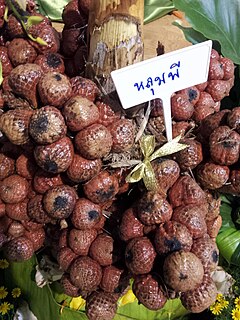
Eleiodoxa is a monotypic genus of flowering plant in the palm family found in Southeast Asia. The only species, Eleiodoxa conferta, is a dioecious, swamp-dwelling plant, commonly called by Malay as asam kelubi or asam paya. While five species names have been published, the other four are usually recognized as synonyms of the lectotype E. conferta. The genus is named from two Greek words meaning "water" and "glory" and the species name is Latin for "congested", an allusion to the flower spike.

Heterospathe is a monoecious genus of flowering plant in the palm family found in Oceania, where it is called sagisi palm. With 39 species, Heterospathe is named from a Greek combination of "various" and "spathe", which describes the two distinct bract types.
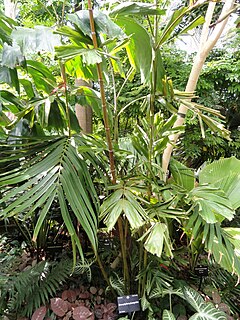
Hydriastele is a diverse and widespread genus of flowering plant in the palm family found throughout Australia and New Zealand, Melanesia, Polynesia, and Southeast Asia. It consisted of just nine species until 2004, when molecular research, supported by morphologic similarities, led taxonomists to include the members of the Gulubia, Gronophyllum, and Siphokentia genera. 48 species are now recognized, of which 38 are new combinations, two are new names and one is a new species. It is named in Greek, combining "hydriad", a water nymph in mythology, and "column".

Iguanura is a monoecious genus of flowering plant in the palm family from Southeast Asia, commonly called pinang. Closely related to the Heterospathe palms, they are noted for producing a wide variety of fruit forms. Its name combines the Spanish word for "lizard" with the Greek word for "tail".

Laccospadix is a monotypic genus of flowering plant in the palm endemic to Queensland. Only one species is known, Laccospadix australasicus, commonly called Atherton palm or Queensland kentia. The two Greek words from which it is named translate to "reservoir" and "spadix".
Lepidocaryum is a monotypic genus of flowering plant in the palm family from South America where the lone species, Lepidocaryum tenue, is commonly called poktamui. Nine species names have been published but palm taxonomists agree that just one variable species includes them all. The most reduced member of the Lepidocaryeae, it is similar in appearance to three closely related genera, Mauritia, Mauritiella, and Lytocaryum. The genus name combines the Greek words for "scale" and "nut" and the species epithet is Latin for "thin".

Lepidorrhachis is a monotypic genus of flowering plant in the palm family restricted to Lord Howe Island. The genus name for the single, monoecious species, Lepidorrhachis mooreana, comes from two Greek word meaning "scale" and "rachis", and the epithet honors Charles Moore, first director of the Sydney Botanical Gardens. The common name is Little Mountain Palm.

Mauritiella is a dioecious genus of flowering plant in the palm family found in South America where it is commonly called buriti. It is named after the similar and closely related genus Mauritia.

Myrialepis is a monotypic genus of flowering plant in the palm family, the single species,Myrialepis paradoxa, native to Southeast Asia. The genus name is a combination of the Greek words meaning "innumerable" and "scale", a description of the fruit, and the epithet is Latin for "paradox".
Nenga is a monoecious genus of flowering plant in the palm family. It is native to Southeast Asia and commonly called pinang palm. N. gajah is the aberration in the genus with its short internodes, marcescent leaves and interfoliar inflorescence, a combination of traits seen in a few species of the closely related Pinanga and Areca palms. The genus name is based on a corruption of a Javanese term for a plant now classified within Pinanga.
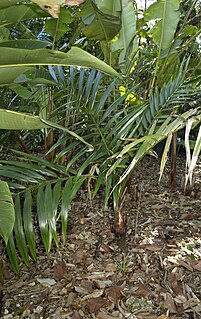
Neonicholsonia is a monotypic genus of flowering plant in the palm family native to Central America. The sole species is Neonicholsonia watsonii. The genus and species names honor George Nicholson, a former curator of the Royal Botanic Gardens, Kew and his successor William Watson.

Oraniopsis is a monotypic genus of flowering plant in the palm family from Queensland, Australia, where the only known species, Oraniopsis appendiculata, grows in mountainous rain forest. Dioecious and extremely slow growing, the name means "similar to Orania" and the Latin epithet translates to "appendaged".
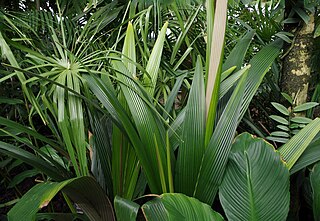
Sommieria is a monotypic genus of flowering plant in the palm family endemic to New Guinea where they grow in rain forest understory. The sole species is Sommieria leucophylla. They resemble the Asterogyne palms but are most closely related to those members of Heterospathe with short stems and sparsely branched inlforescences. The name honors Stephen Sommier, European botanist.
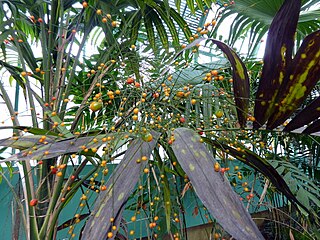
Synechanthus is a monoecious genus of flowering plant in the palm family found in Mexico, Central and South America. Commonly called bola, palmilla, or jelly bean palm, they are closely related to members of Chamaedorea, only distinguished by their flower and fruit form. The Greek genus name is a combination of "united" and "flower".


















